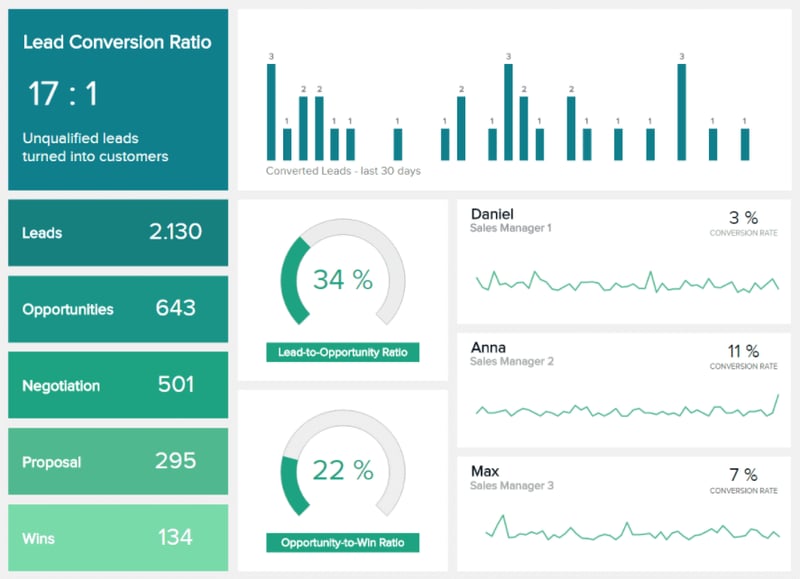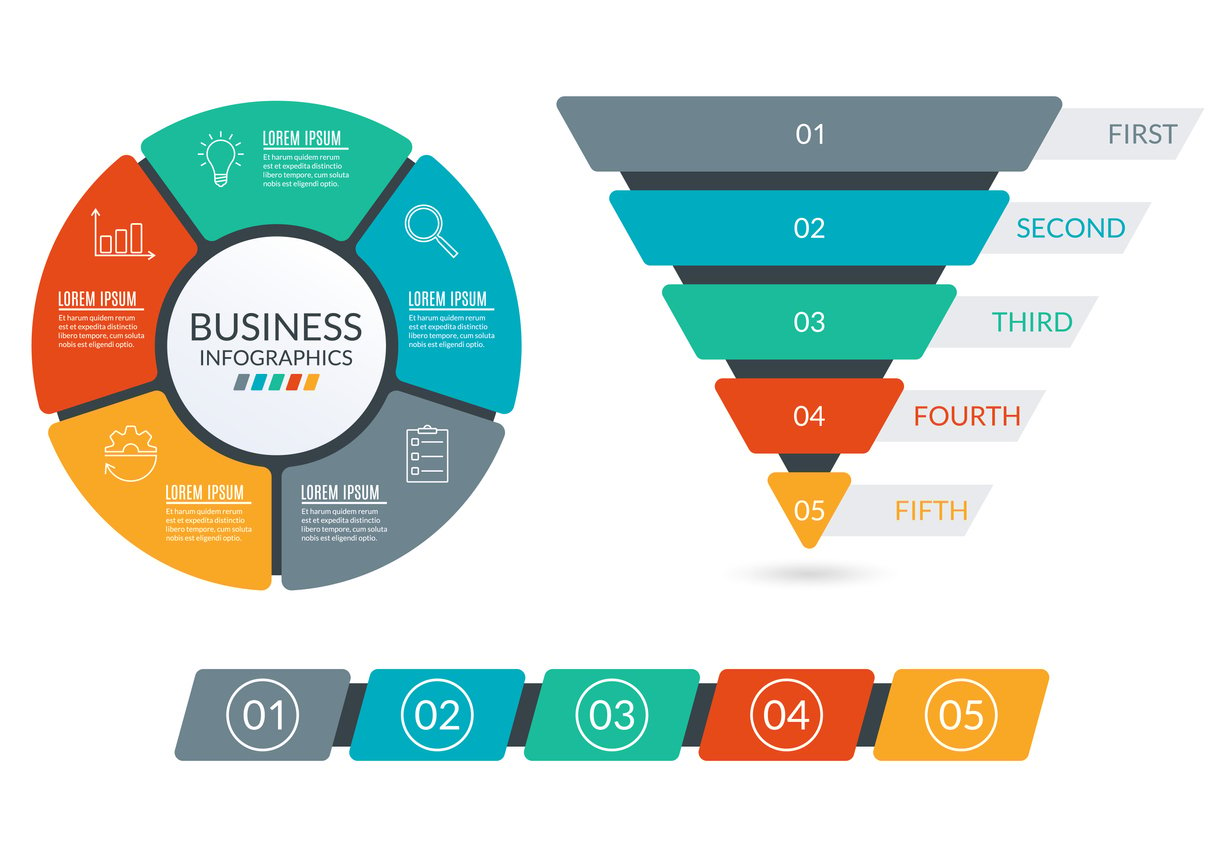
6 Steps to Create the Most Comprehensive Sales Report
 Updated on
Updated on
 By Robins Dorvil
By Robins Dorvil
Robins Dorvil
With over 7 years of experience in the insurance industry, 4+ years as an Account Executive at Ringy CRM, and 17 years as a Creative Real Estate Inves...
learn more
Robins Dorvil
With over 7 years of experience in the insurance industry, 4+ years as an Account Executive at Ringy CRM, and 17 years as a Creative Real Estate Inves...
Table of Contents
Table of Contents
Have you ever found yourself wishing you could boost your sales processes, but discovered you're not even sure where you can find room for improvement?
Well, let's be honest, you probably have a general idea.
But as we all know, you need to be very specific if you want to be effective.
You need to find the weak link in the chain of your sales process, and a sales report is exactly the tool that can get you there. It can identify the problems, highlight possible solutions, and help you realize exactly how much potential your company really has.
And that's definitely not a piece of information you'd like your competition to learn before you do.
So let's see if we can help you win that race, shall we?
What is a Sales Report?
A sales report is a document designed to record and report all the business activities of a specific company.
No, don't worry, that doesn't include the pens you've stolen from the office.
But what it does include is:
- The size of the sales
- Overall revenue over a certain period of time
- Expenses over that same period
- New accounts and leads
- The performance of the sales team and individual members of the team.
But what is the benefit of a sales report?
The answer is simple. In the same way, basketball teams watch videos of their games to determine what they did well and what they did wrong; businesses produce sales reports to try and discover what they do well and where they could improve.
And, generally speaking, there's a lot of room for improvement.
Check out these statistics:
- Only 21.33% of sales emails are opened.
- 35%-50% of sales go to the vendor that responds first.
- 80% of people want to talk to a sales rep via email over any other medium.
- In any given company, at least half of the company's sales prospects are not a good fit for what the company sells.
- Only 18.6% of sales reps report that asking for referrals is part of their standard process
Now, these are interesting statistics, but do they apply to your company? Which side of the fence do you land on? Are your emails getting opened, or are they not? Are your sales prospects a good fit or are they not?
These are the questions different types of sales reports can answer, so that when you look at statistics like that, you know exactly which problems you've already dealt with and which ones still need to be taken care of.
Types of Sales Report
Different types of sales reports are aimed at different parts of the business process.
Now here's a quick overview, if the suspense is killing you:
|
Report Type |
Purpose |
|
Daily/Weekly/Monthly Reports |
Monitor short-term sales performance and team accountability. |
|
Sales Summary Report |
Provide a quick, high-level overview for stakeholders. |
|
Sales Analysis Report |
Explore detailed sales trends, conversion metrics, and customer behavior. |
|
Product/Territory Report |
Evaluate performance by specific products or geographical zones. |
|
Sales MIS Report |
Offer a management-friendly, decision-driven view of sales operations. |
But if this little spoiler has only whetted your appetite, then let's examine the different types more closely.
1. Daily/Weekly/Monthly Sales Reports
These are your frontline sales reports, built for speed and consistency. They track short-term sales activities and revenue generation, helping sales managers keep tabs on performance before small issues become big problems.
Here's how:
- Daily reports might include metrics like calls made, deals closed, or units sold.
- Weekly reports show trends across multiple reps or regions.
- Monthly sales reports aggregate broader trends to aid in forecasting.
These reports are essential if you're asking yourself: How to make a sales report that keeps your team aligned and motivated? Start with these.
Bonus tip: Consistency beats complexity. A simple layout with time-stamped data wins over flashy, convoluted dashboards.
2. Sales Summary Report

The sales summary report is the executive's best friend. It distills vast amounts of sales data into a compact, digestible format that provides quick insight into performance. Here's why it matters:
- Perfect for leadership meetings or investor updates.
- Answers questions like: Did we hit our targets? What was our YoY growth?
It might not be rocket science on its own, but it serves as the foundation for later analysis that helps shape the company's projections and decisions moving forward.
3. Sales Analysis Report
Want to impress the data nerds on your team? This one's your ace.
The sales analysis report goes far beyond numbers. It explores why your sales are up or down, which channels are performing, how your win/loss ratio is evolving, and what customer segments are converting.

Key elements often include:
- Conversion rates by lead source
- Time-to-close metrics
- Churn vs. retention breakdowns
- Customer behavior insights (e.g., purchase frequency)
Identifying the problems with this type of sales report can help a company make the necessary adjustments and provide its sales reps with the tools and/or assistance they need.
4. Product or Territory Sales Report
Need to figure out which product line is carrying the rest? Or why your Midwest team is outpacing the West Coast? That's where this report shines.
This sales report organizes data by:
- SKU or product line: See which offerings are gaining traction.
- Territory or region: Compare performance across branches, reps, or zones.
It's a tactical tool for identifying growth areas and reallocating resources. Especially helpful if you're scaling and need insights to justify expansion (or contraction).
5. Sales MIS Report
The Sales Management Information System (MIS) report is designed for decision-makers who want clarity, not chaos.
It combines multiple data sources into a comprehensive dashboard that supports strategic decisions. This is not a one-pager — it's often a multi-dimensional report that includes:
- Sales KPIs
- Forecasts
- Historical comparisons
- Pipeline health
- Resource allocation
In short, it answers the big questions: Where are we heading? What should we fix?
How to Make a Sales Report

The quality of a sales report hinges above all on the data companies gather about their activities. Now, the amount of data can often be either too small or too big.
If it's too small, you don't have enough to work with. If it's too big, the problem becomes making sense of all the information.
A customer relationship management system can be helpful in that regard. CRMs offer analytics to their users and create reports on various activities that help companies make sense of the information they have in front of them.
Furthermore, once the data has been collected, the creators of the sales report must keep the audience in mind. What are they hoping to learn from the report? Why do they need it? How are the findings of the report supposed to help in their decision-making process?
That said, here's how to make a sales report that resonates with your company's goals:
1. Define Your Audience and Objectives
When it comes to creating a sales report, the first thing you have to do is consider the audience and the purpose behind the report.
Is it intended to inform the sales reps themselves, or is it meant to be used by management?
We all know there are some things you might want to tell management that the sales reps shouldn't hear about.
Your audience will guide you in deciding which parts of the sales process to focus on. If the sales report is supposed to inform the sales reps, then the report might focus on informing them which aspects of their sales methods work well and which ones should be improved.
But if the report is meant for management, then the sales report should focus on the overarching sales process, covering the sales department as a whole.
2. Choose the Right Sales Report Format
Format isn't just about aesthetics—it's about usability.
- Excel/Google Sheets: Great for manual tracking and quick custom reports.
- CRM Dashboards: Ideal for real-time updates and interactive views (think HubSpot, Salesforce).
- PDFs or PowerPoint: Best for polished presentations and executive briefings.
Each format serves a different need. Don't underestimate the power of presentation—especially when you're explaining your sales summary report to stakeholders who value clarity over complexity.
3. Gather and Filter Your Data
Time to get into the weeds—but smartly.
Start by pulling data from your most reliable sources:
- CRM systems like Salesforce or Ringy
- Spreadsheets
- BI tools like Tableau or Looker
Then filter it down. Not every line of data deserves a spotlight. Focus on what moves the needle:
- Revenue by product
- Lead conversion rates
- Win/loss ratio
- Top-performing reps or territories
Remember, a clean sales report beats a cluttered one every time. Show only what matters.
4. Visualize Trends Using Tables, Charts, and Graphs
Numbers are useful. Visuals? They're powerful.
Use:
- Tables for detailed breakdowns
- Bar and line charts to highlight trends over time
- Pie charts sparingly—for things like revenue distribution by product or region
A well-crafted sales analysis report should highlight patterns at a glance. Think of visuals as your report's body language—they should tell a story even without a narrator.
5. Provide Actionable Insights—Not Just Numbers
Don't just dump data. Interpret it.
Instead of saying:
- "Revenue from Product A increased by 12%."
Say:
- "Revenue from Product A increased by 12%, likely due to the Q2 email campaign targeting repeat customers. Consider replicating this strategy for Product B."
Whether you're delivering a sales MIS report or a simple weekly update, insight is your value-add. Otherwise, you're just another spreadsheet in someone's inbox.
6. Schedule Report Delivery (Daily, Weekly, Monthly)
The best sales reports are timely. Don't leave them gathering dust on a desktop. Here's how to do it right:
- Daily reports = Operational visibility
- Weekly reports = Team accountability
- Monthly reports = Strategic alignment
Pick a rhythm that matches your business needs. And don't make it a manual chore—automation is your friend here.
Pro Tip: Use Ringy's Customizable Reporting Dashboard
Manually pulling data is so 2010. If you're using Ringy, take full advantage of its reporting dashboard. You can:
- Customize the layout
- Set automated report delivery
- Track KPIs in real time
This way, your sales report practically writes itself, leaving you more time for strategy and less time wrangling spreadsheets.
Bottom line? Making a great sales report is part science, part storytelling. Define your purpose, pick the right tools, and deliver insights that make your data actionable. That's how you turn a boring report into a business game-changer.
Top 7 Sales Report Tips

A sales report should do more than check a box—it should drive action, spark conversations, and steer decisions. But to get there, you need to go beyond the basics.
Here are the top tips to make your reports not just readable, but downright impactful.
|
Tip |
Key Benefit |
|
Choose Metrics That Match Goals |
Keeps the report aligned with your actual sales objectives. |
|
Keep it Visual |
Makes trends and anomalies easy to spot. |
|
Segment by Source or Lead Vendor |
Helps evaluate channel performance and maximize ROI. |
|
Automate with CRM Tools |
Saves time and reduces manual errors. |
|
Compare Period Over Period |
Reveals performance trends and growth patterns. |
|
Include Win/Loss Reasons |
Improves future strategy by understanding deal outcomes. |
|
Use Filters and Custom Views |
Personalizes reports for different roles and decision levels. |
1. Choose Metrics That Match Your Goals
Tracking every available KPI might make your spreadsheet look impressive, but it also turns your sales summary report into a cluttered mess.
Instead:
- Tie metrics to actual sales goals.
- If you're focusing on revenue growth, track average deal size and upsell rates.
- If your priority is lead generation, spotlight conversion rates and funnel velocity.
Remember: a focused sales report is a useful one. Data should support your strategy, not distract from it.
2. Keep It Visual

Let's face it—no one loves squinting at a wall of numbers. That's why visuals are your best friend.
Use:
- Pie charts to show the share of revenue by product.
- Bar graphs to track rep performance or monthly trends.
- Pipeline views to visualize deal progression.
Even the most data-averse stakeholders will appreciate a well-designed sales analysis report that makes insights pop.
3. Segment by Source or Lead Vendor
One of the most underused tactics in sales reporting: segmenting by where leads came from.
Why does it matter?
- It shows which channels (email, paid ads, referrals) actually convert.
- It reveals which lead vendors deliver high-quality prospects.
- It lets you cut budget waste and double down on ROI-generating sources.
This is especially powerful in sales MIS reports, where decision-makers need clarity on marketing-to-sales performance.
4. Automate with CRM Tools
Manual reporting is a productivity killer and an error magnet.
Use CRM platforms like Ringy to:
- Auto-generate daily, weekly, or monthly sales reports
- Create custom dashboards for reps or managers
- Eliminate human error and data delays
As a result, you get more time to close deals instead of copy-pasting data
5. Compare Period Over Period
A single number means little without context. Comparing performance over time turns a stat into a story.
Try:
- Month-over-month to catch short-term shifts
- Quarter-over-quarter to assess broader trends
- Year-over-year for seasonal business benchmarks
Your sales summary report becomes ten times more insightful when it shows momentum or red flags over time.
6. Include Win/Loss Reasons
Here's a game-changer: document why deals are won or lost.
Use fields in your CRM to track:
- Pricing objections
- Feature gaps
- Competition
- Timing
Adding win/loss data to your sales analysis report helps you:
- Refine pitches
- Improve product positioning
- Close similar future deals more efficiently
It's not just about closing more—it's about understanding how and why it happens.
7. Use Filters and Custom Views
No two users want the same thing from a sales report.
Sales reps want personal performance, managers want team breakdowns, and executives want strategic overviews.
So, use filters and custom views to deliver:
- Region-specific reports
- Rep-by-rep dashboards
- Stage-based pipeline snapshots
Custom views turn a generic sales MIS report into a personalized command center. One size does not fit all—and that's a good thing.
The 3 Best Sales Report Tools
So now that we've examined every aspect of a sales report, let's see which tools can help you improve the creation process.
1. Ringy

It's shocking that our own CRM would be the first one listed, we know.
But that's because it's by far the best example of a sales CRM, Ringy is a sales reporting solution every company needs as a part of their arsenal. The software aims to provide companies with the ability to streamline their sales process and gain a clear insight into their business process.
The software's features include:
- Qualifying leads
- Analytics and reports
- Automation
- Communications tracking
- Easy integration
The software is a must-have for any sales department of any company. Companies need to enjoy the software's benefits, especially if their competition is enjoying them as well.
But don't take our word for it. You can check out what Ringy's customers have to say right here.
And if you're interested in finding out the investment Ringy requires, you can find out all about it here.
2. Domo

Domo is a business cloud platform that aims to unite all the departments, systems, and software under a single roof. The goal is to give organizations the ability to easily track their business process and share the data with employees in an easy, secure way. The gathering of data on a single platform, coupled with the ease with which employees can access them, makes writing sales reports a walk in the park.
Domo offers features like:
- Full integration
- Visualization tools
- Building data apps
- Security
When it comes to the customer experiences, people rave about Domo's visualization features, though some claim the performance of reports decreases with larger data piles. You can check out more reviews here.
Domo's pricing is adjustable, depending on specific customers. You can learn more about it here.
3. Gong

Gong is a top-of-the-line revenue intelligence platform designed to help businesses gain clear insight into the sales process by recording, transcribing, and analyzing the sales calls made by each and every one of your sales reps.
It's an amazing tool that can not only help facilitate sales reports that offer detailed insight, but it also offers the opportunity for a quicker onboarding process and better employee training.
Gong offers a range of features, including:
- CRM integration
- Calendar integration
- Recording communications
- Call transcriptions
- Analytics
Gong offers customized pricing structures for each customer. You can learn more about it here.
Ignore the Potential of Sales Reports at Your Own Risk
Sales reports might seem like an unnecessary annoyance. Another piece of bureaucracy that'll clog up the system with useless information and have the company waste resources on projects no one cares about.
That couldn't be further from the truth.
Sales reports have the power to illuminate the foggy parts of a business process and provide a company with the direction it needs to move if it means to advance and grow.
Companies that recognize the possibilities of sales reports can make informed decisions moving forward, while the companies that ignore them might be left scrambling in the dark, merely guessing at what could be improved.
So if you don't want to end up like the latter, contact Ringy today and request a demo to discover how a sales report might help take your company to the next level.

Skyrocket your sales with the CRM that does it all.
Calling? Check. SMS? Check. Automation and AI? Check. Effortlessly keep in touch with your customers and boost your revenue without limits.

Take your sales to new heights with Ringy.
Sales in a slump? Ringy gives you the tools and flexibility you need to capture leads, engage with them, and turn them into customers.
Subscribe to Our Blog
Enter your email to get the latest updates sent straight to your inbox!
Categories
Related Articles



































































































